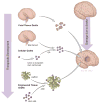Stem Cell-Based Tissue Replacement After Stroke: Factual Necessity or Notorious Fiction?
- PMID: 26106118
- PMCID: PMC4519410
- DOI: 10.1161/STROKEAHA.114.007803
Stem Cell-Based Tissue Replacement After Stroke: Factual Necessity or Notorious Fiction?
Keywords: brain; nerve regeneration; neurons; stem cell transplantation; stroke; tissue engineering; tissue-type plasminogen activator.
Figures



References
-
- Hacke W, Kaste M, Bluhmki E, Brozman M, Davalos A, Guidetti D, et al. Thrombolysis with alteplase 3 to 4.5 hours after acute ischemic stroke. N Engl J Med. 2008;359:1317–1329. - PubMed
-
- Balami JS, Sutherland BA, Buchan AM. Complications associated with recombinant tissue plasminogen activator therapy for acute ischaemic stroke. CNS Neurol Disord Drug Targets. 2013;12:155–169. - PubMed
-
- Langhorne P, Bernhardt J, Kwakkel G. Stroke rehabilitation. Lancet. 2011;377:1693–1702. - PubMed
Publication types
MeSH terms
Grants and funding
LinkOut - more resources
Full Text Sources
Medical

